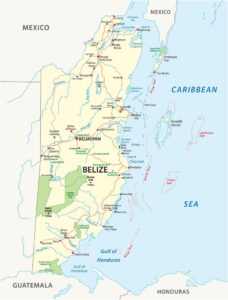Throughout the centuries, the territorial boundaries of Belize have been shaped by a multifaceted and contentious historical narrative. You may often find yourself contemplating the significance of the dotted depiction of the border on various maps, which visually embodies a deeply rooted territorial dispute. This ongoing conflict has its origins in historical claims put forth by Guatemala, a nation that has persistently contested Belize’s sovereignty since its independence. The potential for international tensions remains substantial, as both countries engage in diplomatic dialogues aimed at resolving this boundary issue. Your exploration of this geopolitical puzzle unveils the intricate challenges surrounding national borders in Central America, where colonial legacies and concepts of territorial integrity frequently intersect in potentially volatile ways.
Investigating the Historical Claims Contributing to the Belize-Guatemala Dispute
The persistent territorial conflict between Belize and Guatemala can be traced back to complex historical and colonial legacies. This dispute originated during the colonial period when territorial boundaries were often poorly defined and open to interpretation. The longstanding unresolved border issue has persisted for centuries, leading to continuous tension between these neighboring nations and significantly influencing their diplomatic relations. Understanding the historical context of this conflict not only complicates the comprehension of current territorial disputes but also emphasizes the lingering effects of colonialism on modern statehood and national identity.

Examining Guatemala’s Persistent Territorial Claims over Belize
Guatemala has consistently maintained a historical claim of territorial rights over Belize, rooted in its interpretation of the Spanish colonial administrative boundaries. You might be surprised to learn that Guatemala views Belize as part of its original territorial inheritance from the Spanish Empire, thereby challenging the modern borders that were established during the British colonial period. This historical perspective continuously fuels Guatemala’s claims and adds complexity to the issue of sovereignty, as both populations grapple with the ramifications of these deeply entrenched assertions.
Understanding the Impact of Historical Borders on Contemporary Relations
Since the colonial era, these disputed boundaries have posed significant geopolitical challenges for both nations. It becomes evident how undefined border regions can create potential for conflict and diplomatic tensions, which directly affect local communities and national sovereignty. A comprehensive understanding of the border dispute reveals intricate layers of historical, legal, and territorial dynamics that unfold in real time. The implications of this conflict extend beyond mere geographical demarcations, encompassing economic, cultural, and security risks that threaten regional stability, international law, and the prospects for future diplomatic negotiations between Belize and Guatemala.
Significance of the Dotted Line Represented on Maps
When examining various maps, you may observe a distinctive feature: a dotted boundary line between Belize and Guatemala, which symbolizes a persistent territorial dispute that has lasted for decades. This unique cartographic representation encapsulates a complex geopolitical challenge, where the precise border remains undefined and contested. The dotted line stands as a symbol of the ongoing diplomatic tensions and the unresolved territorial claims that have characterized the relationship between these two Central American nations over the years. Grasping the implications of this representation is vital for understanding the broader context of their diplomatic relations.
International Recognition Amidst the Ongoing Border Dispute
In the landscape of international relations, Belize is acknowledged as a sovereign state with an established international presence; however, the disputed border with Guatemala presents a nuanced geopolitical scenario. You may find it intriguing that while Belize gained independence in 1981, Guatemala has historically challenged its territorial integrity. The dotted line not only highlights geographical uncertainty but also represents an ongoing diplomatic negotiation that continuously shapes regional relations and international perceptions.
The Diplomatic Importance of the Dotted Line Representation
Beyond its mere representation on maps, the dotted line acts as a significant diplomatic symbol. You can interpret it as a visual manifestation of unresolved territorial claims, signaling to the international community the intricate negotiations occurring between Belize and Guatemala. This distinctive border marking conveys the ongoing dialogue and the potential for a peaceful resolution of the conflict. However, the dotted line symbolizes more than just a cartographic curiosity; it embodies a delicate diplomatic instrument designed to prevent potential military escalation while maintaining open channels for negotiation.
This line serves as a strategic buffer, allowing both nations to preserve diplomatic relations and work towards a feasible resolution in the future. Its existence illustrates how international borders can be managed through peaceful means, showcasing an evolved approach to territorial disputes that prioritizes dialogue over confrontation.

Exploring Major Conflicts and Diplomatic Efforts Between Belize and Guatemala
The territorial disputes between Belize and Guatemala are deeply rooted in history and characterized by complex diplomatic tensions and unresolved boundary claims. You will discover that the ongoing disagreement revolves around competing interpretations of colonial-era treaties and the intricate concept of territorial sovereignty. This dispute has far-reaching implications for both nations, encompassing potential land ownership challenges and regional geopolitical dynamics that continue to influence their relationship.
The Impact of the 1859 Treaty and Subsequent Developments
Prior to the signing of the 1859 treaty between Britain and Guatemala, territorial boundaries within the region were ambiguous and fiercely contested. It is crucial to understand that this agreement aimed to establish clear borders; however, subsequent interpretations have led to ongoing disputes. Guatemala consistently questions the validity of the treaty, asserting that Britain failed to fulfill certain commitments regarding infrastructure development, which has become a central point of contention in their territorial disagreement. This historical context is vital for comprehending the lasting implications of the treaty.
Engagement of the International Court of Justice and Recent Diplomatic Efforts
Recent diplomatic initiatives have concentrated on resolving the enduring border dispute through international legal channels. You will note that both nations have consented to submit their case to the International Court of Justice (ICJ) for a binding resolution. This strategy signifies a considerable step towards peaceful conflict resolution and the possible normalization of bilateral relations. Alongside the ICJ proceedings, it is essential to acknowledge the complex diplomatic negotiations that have transpired, reflecting the intricate web of interests involved.
The potential referendum in both countries to validate the ICJ’s decision represents a unique approach to addressing territorial disputes. Your awareness of this process underscores the delicate diplomatic efforts to maintain regional stability and resolve historical territorial claims through peaceful, internationally recognized mechanisms capable of redefining the relationship between Belize and Guatemala.
Assessing the Current Situation and Essential Travel Considerations
Many travelers are fascinated by the unique border configuration of Belize with Guatemala. The ongoing territorial dispute has created a complex geopolitical landscape that directly influences travel and border crossings. Despite the prevailing tensions, tourists continue to explore both countries, navigating the delicate diplomatic situation while considering international boundaries and local regulations. Understanding these dynamics is vital for ensuring a safe and enjoyable travel experience in the region.
Essential Guidelines for Safely Navigating the Belize-Guatemala Border
When planning international travel to Belize, it is crucial to prepare thoroughly and consider the following important guidelines:
- Always carry a valid passport and any necessary travel documents to facilitate seamless border crossings.
- Stay updated on the current state of diplomatic relations between Belize and Guatemala before embarking on your journey to avoid complications.
- Acquire comprehensive travel insurance for your trip to protect against unexpected events.
- Remain informed about border crossing procedures to sidestep any potential complications during your travels.
The most essential aspect is to maintain awareness of your surroundings and adhere to local regulations to guarantee a smooth travel experience while being mindful of the historical context surrounding the border.
Understanding Local Perspectives and Community Sentiments on the Dispute
Behind the border dispute lies a complex tapestry of historical tensions and intricate cultural dynamics. Communities situated near the border experience the direct consequences of the dispute, with generational memories of conflict significantly shaping their perspectives. Residents often navigate the delicate balance between national pride and a desire for peaceful coexistence, highlighting the human element inherent in this geopolitical issue. Their narratives reflect the broader ramifications of territorial disputes on local populations.
Gaining Deeper Insights into Community Dynamics near the Border
To truly comprehend the local perspective, it is beneficial to explore the nuanced landscape of cultural identity. You will find that border communities have devised unique survival strategies, blending resilience with diplomatic pragmatism in the face of adversity. Indigenous groups, in particular, play a pivotal role in fostering cross-border relationships, often transcending official diplomatic tensions through grassroots connections and shared cultural experiences, thereby promoting a sense of unity despite the ongoing conflict.

Anticipating Future Implications of the Belize-Guatemala Border Dispute on Regional Dynamics
Despite the continuous territorial dispute, there exists the potential for significant geopolitical transformations. The ongoing border issue between Belize and Guatemala continues to generate tension, with implications that could redefine diplomatic relations in Central America. You may observe that resolving this dispute could profoundly impact regional stability, economic cooperation, and the international perceptions of both nations, influencing not just bilateral relations but also broader regional dynamics.
Continuing Dialogue and Negotiations Between Belize and Guatemala
Dialogue remains the primary mechanism for addressing the territorial disagreement. You will find that both countries have engaged in diplomatic discussions, seeking peaceful resolutions through international platforms such as the Organization of American States (OAS). These conversations exemplify a commitment to avoiding military confrontation and finding a mutually acceptable solution to their protracted border dispute, thereby emphasizing the importance of dialogue in conflict resolution and promoting stability.
Exploring Viable Pathways Towards a Lasting Resolution
Above all, it is essential to recognize that multiple strategies exist for resolving the border conflict. International mediation and bilateral negotiations offer potential pathways for progress. You might consider approaches such as joint territorial management, referendums, or interventions from international courts as viable methods to effectively address the dispute. Each of these options comes with its unique set of challenges and opportunities for both nations.
The implications of resolving the conflict extend far beyond simple border demarcation. You will discover that successful negotiations could unlock significant economic opportunities for both Belize and Guatemala. Potential advantages may include enhanced trade, improved cross-border cooperation, and increased foreign investment. The most transformative outcome would be the establishment of permanent territorial sovereignty, which could dramatically diminish regional tensions and foster long-term stability in Central America, nurturing a more harmonious relationship between the two nations.
Comprehending the Regional Dynamics of the Belize-Guatemala Conflict
Distinct from other border disputes in Central America, the Belize-Guatemala territorial conflict is steeped in deep historical complexities that have significantly influenced regional geopolitical interactions. You will find that this longstanding disagreement reflects broader patterns of territorial tension, involving colonial legacies, post-independence territorial claims, and intricate diplomatic negotiations that have profoundly shaped the political landscape of the region. Understanding these dynamics is essential for comprehending the implications of historical disputes on contemporary relations.
The Impact of the Dispute on Central American Relations and Cooperation
After decades of territorial disputes, you can observe how this conflict has strained diplomatic relationships between Belize and Guatemala. The ongoing tension has periodically disrupted regional cooperation, creating challenges for economic integration and mutual understanding within the broader Central American community. The implications of this strain extend to regional initiatives that could benefit from a more cooperative approach.
The Role of International Organizations in Mediation Efforts
With diplomatic mediation playing a critical role, international organizations have actively participated in efforts to resolve the border dispute. You will notice that entities like the Organization of American States (OAS) have been instrumental in facilitating dialogue and proposing feasible resolution strategies. Their involvement highlights the importance of international cooperation in addressing complex territorial issues.
A comprehensive network of international organizations has been strategically engaged in addressing the Belize-Guatemala border dispute. The United Nations, OAS, and various diplomatic channels have worked tirelessly to prevent escalation, offering mediation services and promoting peaceful negotiation. You will appreciate how these organizations have been vital in maintaining stability, providing a structured approach to resolving territorial disagreements and mitigating potential military confrontations.
Reflecting on the Complexities and Challenges of the Belize-Guatemala Border Dispute
When weaving together the intricate threads of Belize’s territorial history, you can see how the nation’s border with Guatemala serves as a testament to unresolved colonial legacies. As you delve into this geopolitical puzzle, you’ll come to understand that the dotted border signifies more than a mere cartographic curiosity; it encapsulates ongoing diplomatic negotiations and historical tensions. Your comprehension of this dispute reveals the intricate challenges facing post-colonial states, where territorial boundaries continue to ignite international dialogue. The unresolved status underscores the delicate balance between historical claims and modern diplomatic solutions, inviting you to appreciate the nuanced complexity of international border disputes.

Your Inquiries Addressed: Frequently Asked Questions Regarding the Belize-Guatemala Border Dispute
What is the significance of the dotted border between Belize and Guatemala?
The dotted border signifies a long-standing territorial dispute between Belize and Guatemala, originating from conflicts that date back to the colonial era. Spain originally claimed the territory, and after Belize attained independence from Britain in 1981, Guatemala continued to assert its territorial claims, resulting in an undefined border demarcation illustrated by the characteristic dotted line on maps, representing ongoing discussions and unresolved issues.
Has any resolution been achieved regarding the border dispute between Belize and Guatemala?
While the dispute remains partially unresolved, significant progress has been made. In 2019, both countries agreed to present the territorial disagreement to the International Court of Justice (ICJ) for a binding resolution. A referendum in both nations supported this approach, signifying a diplomatic pathway toward definitively settling the border controversy and showcasing their commitment to resolving the issue through international law.
What are the historical origins of the border conflict between Belize and Guatemala?
The conflict stems from the 1859 treaty between Britain and Guatemala, which promised infrastructure development in exchange for territorial recognition. When Britain failed to fully meet these commitments, Guatemala began to challenge Belize’s territorial integrity. This historical misunderstanding has perpetuated decades of tension, with Guatemala maintaining claims over approximately 53% of Belize’s current national territory, thus complicating diplomatic efforts.
The Article Why Is Belize’s Border Dotted? Exploring the Guatemala Dispute appeared first on Belize Travel Guide
The Article Belize’s Border Dotted: Unraveling the Guatemala Dispute Was Found On https://limitsofstrategy.com
The Article Belize’s Border Dispute: Unraveling the Guatemala Conflict First Appeared ON
: https://ad4sc.com










Comments are closed